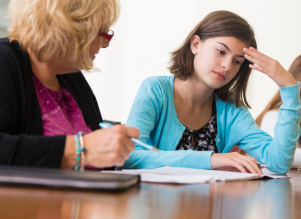7/30/2018
Re-engaging Dropouts Through Relationships, Personalization, and Blended Learning
Since 2000, schools across the nation have been seeing results from dedicated efforts to increase the nation’s graduation rate and to reduce the number of students who drop out. Indeed, the national graduation rate rose to almost 75 percent in 2010—the highest point since 1973, according to Education Week’s new Diplomas Count report. Back in 2000, only two-thirds of students graduated from high school, but by 2015, the national graduation rate rose to a record high of 83.2 percent, moving closer toward the 90-percent goal established by GradNation and former President Obama.
These numbers are exciting to the educators and administrators working hard to ensure every student succeeds. However, the statistics also shed light on another group of students who may not be served by existing prevention efforts—those who re-enroll after dropping out. These students may need specialized support to help them stay engaged and complete their degrees.
Relationships matter
Research suggests that students who drop out of school do so due to myriad causes, including:
-
Academic troubles
-
Health matters
-
Financial demands
-
Family situations
-
Pregnancy or parenting duties
-
Drug use
-
Homelessness
Regardless of whether an individual student's reasons for dropping out fall under the umbrella of institutional or individual characteristics, it has been noted that “rates of disconnection” tends to be a major contributing factor, and interviews with affected youth conducted by the America’s Promise Alliance showed that relationships have the potential to impact both disengagement and the re-engagement process. In other words, how we as educators approach teaching and interacting with students who are newly re-enrolled really matters.
Successful re-engagement programs provide for the needs of each student, helping them learn and obtain the tools and skills they need to graduate, such as:
-
Academic interventions
-
Job skill training
-
Health and hygiene resources
-
Other targeted interventions
Ensuring that a student’s basic needs are met is an important part of maintaining attendance, but once they're in school, how do we as educators keep them engaged? The answer may lie with personalized learning and blended learning opportunities.
Involve the student in decision-making and implement personalized learning
Changing Systems to Personalized Learning, a series of workshops by The Educational Alliance at Brown University, aims to teach educators how to adapt practices in a way that increases engagement through personalized learning. The workshops ask the question, “How much does the student direct the process of his or her own learning?” and "have found that higher levels of student self-direction are correlated with higher levels of student commitment to their education and graduation."
Taking this into account, it is important that students who re-enroll in school are provided with the opportunity to have a say in their journey, and to express both what they would like to accomplish and how they would like to do it. Practitioners call this kind of experience personalized learning.
Done at a large scale, personalized learning can lead to dramatic results. After undergoing a major transformation and becoming a self-paced, anytime-learning environment, one school in Kentucky enjoyed five years of zero dropouts thanks to its creation and implementation of individual learning plans. Even on a small scale, personalized learning can help students feel that what they care about and are interested in matters, and that the school is committed to helping them find their path to success.
Reach more students through blended learning
Blended learning can help accomplish both relationship-building and personalization at scale. Such programs, which offer a combination of online or virtual learning and classes in more traditional education settings, have played an important role in credit recovery for high school dropouts.
In fact, blended learning programs that offer real-life support have been shown to be more effective than online-only recovery programs, as they provide the opportunity to re-engage in a manner or time frame that works with each student's needs and current personal situation.
States such as Washington and major districts including the Los Angeles Unified School District have expanded blended-learning opportunities because these are considered to be “a more feasible and scalable approach to enhancing diploma programs than traditional classroom-based models” (Center for Promise, America’s Promise Alliance).
While large scale re-engagement centers and programs are especially effective in getting former dropouts to graduation, the tools they use—specifically relationship-building, personalized learning, and blended learning—can be implemented by every educator and school district to reach and re-engage high school dropouts.


